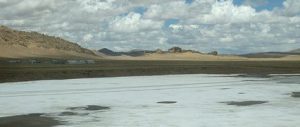Some extraordinary finds have been made recently in the natural world. Among them: a remarkable 163 new species of flora and fauna discovered in the jungles and rivers of south-east Asia’s Greater Mekong region – new orchids, snakes, lizards and wild bananas. And in the pristine crater of an extinct volcano in Papua New Guinea, a giant rat, tree-living kangaroos and possibly up to 40 other new species have been recorded, with some shown on television for the first time.
As these diverse new wonders are revealed, however, other animals and plants are declining in number, becoming increasingly endangered. Some unique but little known species among the 1,899,587 recorded on the earth face the possibility of extinction, while others may vanish before they are even discovered and catalogued. And many animals that are popular with the public today also may be gone by 2050, some scientists say, as their habitats are altered beyond what they can cope with. While extinction is the end, it is preceded by a scarcity – a growing absence – of diverse life forms that also saddens lovers of nature.
A three-year search for the giant Chinese paddlefish, conducted along nearly 500 kilometres of the upper Yangtze, failed to find a single individual. From 2006 to 2008, researchers from the Chinese Academy of Fishery Sciences (CAFS) deployed thousands of setlines and hundreds of driftnets in an unsuccessful attempt to catch the fish, which was last seen in January 2003. Experts fear that the paddlefish – which could grow to seven metres in length – has met the fate of the baiji, or Yangtze River dolphin, now declared extinct.
The environmental organisation WWF, in its report on the recent Mekong discoveries — Close Encounters – noted that the diverse species and habitats of that region “continue to face a wave of ever-growing threats, including habitat loss, infrastructure development and unsustainable and illegal natural-resource use”. These threats, says WWF, are being compounded by climate change: global warming as well as more frequent extreme events, such as droughts and floods, which also cause loss of human life and damage to property.
“Climate change is altering the availability of freshwater; important disturbance regimes like flooding duration, timing and extent; species ranges; and the timing of migration and flowering,” WWF said. “Combined with non-climate threats, these changes gravely threaten many of the region’s unique species”, including some of the just-discovered plants and animals.
Because climate change impacts species in different ways, notes WWF, some will be able to adapt, but many will not. Those with low tolerance to warming or altered rainfall patterns, and a limited ability to acclimate or disperse, are at great risk of extinction.
“Rare, endangered and endemic species and those living in mountain ecosystems are especially vulnerable because climate change will further shrink their restricted habitats,” says the WWF report. “Species that are highly dependent on just a few or even one other species are also at risk because those species may respond to climate change in ways that disrupt the tightly evolved relationships.”
As a result of a number of factors stemming from changes in precipitation and temperature, according to the environmental organisation, “climate change is expected to cause large-scale changes in ecosystem structure, composition and processes”. Changes in seasonality, for example, will affect wetlands and ponds that are critical sources of water, food and habitat in dry forests.
Human actions, too, play a significant role in the decline of species. Amid continuing concern over the fate of the world’s tigers, campaigners and scientists have warned often that the iconic animal – sought for its skin and body parts used in traditional remedies — will disappear unless the international community comes up with new strategies to ensure its survival. In a video message to a recent conference in Kathmandu, World Bank president Robert Zoellick said that traders and poachers were “better organised” than policy makers and conservationists.
Zoellick noted, too, that the present illegal trade in wildlife is estimated at more than US$10 billion a year across Asia – “second only to weapons and drug smuggling”. Rhinoceroses are in peril in southern Africa, as poachers kill them for their horns, which also are used in traditional medicine and for decorative items.
In Australia, the world’s only census of animal and plant life found that nearly 10% of the planet’s major vertebrate species were threatened. Reported endangered were 20.8% of mammal species, as well as 12.2% of birds, 29.2% of amphibians, 4.8% of reptiles and 4.1% of fish. The Pacific island nation of Palau is pioneering a marine sanctuary to protect more than 130 species of shark – prized for their fins – as well as stingrays. The tiny county has scant resources, however, to enforce its intentions in a sea area the size of France.
The Red List of Threatened Species, produced by the International Union for the Conservation of Nature (IUCN), is the main authority on the conservation status of plant and animal species. In Wildlife in a Changing World, an analysis of the 2008 Red List, 44,838 species were studied. The report shows 869 species are extinct or extinct in the wild, a figure that rises to 1,159 if the 290 critically endangered species labeled as possibly extinct are included.
Overall, according to the IUCN, a minimum of 16,928 species are threatened with extinction. “Considering that only 2.7% of the 1.8 million described species have been analysed,” the organisation said, “this number is a gross underestimate, but it does provide a useful snapshot of what is happening to all forms of life on earth.”
In the recently released 2009 update to the Red List, the planet’s amphibians were deemed the most threatened of all species, with 1,895 of 6,285 assessed species threatened with extinction.
Around the world, animals that have become extinct, or are on the brink, include the West African black, the northern white and the Javan rhinos, the Iberian lynx, Asia’s saiga antelope, the central African cross-river gorilla, Russia’s Amur leopard, Costa Rica’s golden toad, Madagascar’s aye-aye lemur and the Amazonian manatee. In trouble, too, is some plant and bird life in Hawaii, as well as Lebanon’s wild cedars, some sturgeon species, honeybees and delicate flowers like slipper orchids and eidelweiss. Concern also has been raised for other primates and sea creatures – and for the earth’s magnificent coral reefs. Others worry that the taste of fish may be something that future generations will only hear about, as stock continue to collapse due to over-fishing and pollution.
The fate of the polar bear is becoming particularly critical as Arctic sea ice melts. Dependent on the icy for hunting and breeding, the bears are losing their far-northern habitat. At least eight of the 19 subpopulations of polar bears are declining in numbers, say scientists. Some reportedly have drowned, exhausted from long swims, without food and without encountering ice.
While the world’s other favourite bear, China’s giant panda, is said to be increasing in number in the wild, it remains – as “charismatic megafauna” – a symbol of what the world stands to lose as habitats vanish. Mark Wright, chief scientist at the WFF, and Chris Packham, a naturalist and BBC television presenter, recently debated the panda’s fate in The Guardian. Packham argued that the animal may have had its day in raising the profile of conservation.
“The panda,” he wrote, “is a species of bear that has gone herbivorous and eats a type of food that isn’t all that nutritious, and that dies out sporadically. It is susceptible to various diseases, and, up until recently, it has been almost impossible to breed in captivity. They’ve also got a very restricted range, which is ever decreasing, due to encroachment on their habitat by the Chinese population. Perhaps the panda was already destined to run out of time.”
Maybe, Packham suggested, “if we took all the cash we spend on pandas and just bought rain forest with it, we might be doing a better job.”
Acknowledging that “really horrible” choices have to be made in conservation, given the finite resources available, Wright argued that “the part of China where pandas live should be on the preservation list anyway”. The giant panda, he noted, shares its habitat with the red panda, golden monkeys and various birds that are found nowhere else.
Charismatic megafauna – large animals that appeal to people’s emotional side – can be “extremely useful”, according to Wright. “Smaller creatures often don’t need a big habitat to live in, so in conservation terms it’s better to go for something further up the food chain, because then, by definition, you are protecting a much larger area – which in turn encompasses the smaller animals.”
Either way, a number of animal species – and plants – appear certain to vanish from the earth as the planet warms over the coming decades.
Maryann Bird is associate editor of chinadialogue
What species do you expect to disappear in your lifetime? Which do you think future generations may never see? How can the planet’s extraordinary species and ecosystems be given a chance to cope with climate change? How far should we go in trying to save a species? Should some be allowed to die out?
Let us know on the forum what you think …
Homepage image by fruchtzwerg



